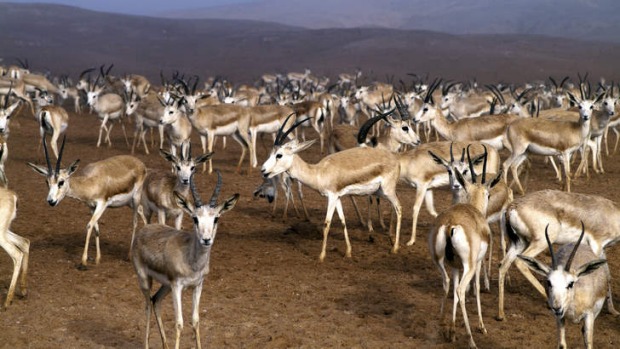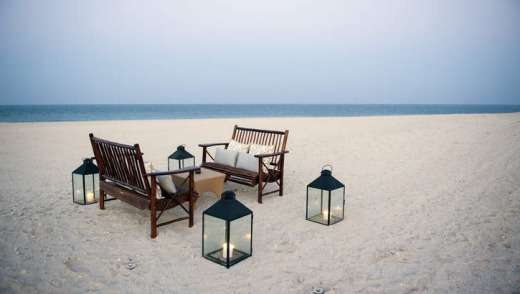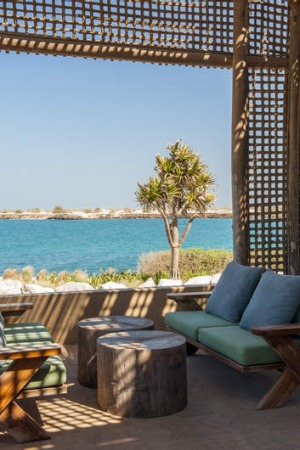
A sheik's private nature reserve is now a resort island, Leisa Tyler says.
At first glance, Sir Bani Yas looks like any other rocky outcrop peppering the Persian Gulf. The tear-shaped island textured with craggy mountains of rust-coloured earth is ringed with coves of snow- white sand and aquamarine wavelets. Look a little longer and Sir Bani Yas reveals itself to be a whole lot more than just another barren island in a shimmering sea of stunning blue.
The once private retreat of the United Arab Emirates' founder, the former Sheikh Zayed Bin Sultan Al Nahyan, Sir Bani Yas is being planted with millions of trees, stocked with exotic wild animals from the Gulf and African regions and reinvented as the Arabian Wildlife Park.

The park's objectives are two-fold: To offer tourists and Gulf residents an opportunity to explore their great outdoors with safari, mountain bike, horse riding and kayaking excursions and to breed animal species that are endangered or extinct in the wild. There are 30 animal species on the 87-square-kilometre island, including the Arabian oryx, recently reintroduced into the wild after becoming extinct.
The Arabian Wildlife Park is the brainchild of the Abu Dhabi-based Tourism & Cultural Authority (TCA) and Tourist Development Investment Company (TDIC), under direction of the Sheikh's office. "The Emirates is well known for its oil, but not conservation efforts," says Steven Phillips, the general manager of the Anantara Sir Bani Yas resorts, the only tourist facility on the island.
Bangkok-based Anantara run three resorts on the island. The first, Desert Islands, opened in one of the royal palace's former guest houses in 2008. Set on its own peninsula, with a natural inlet filled with pink-bellied flamingos on their migratory path, the mid-level property has 64 rooms in Arabic style. Most are in the main building, a dust-coloured fortress fitting for the surrounds. The rest of the rooms are in villas; longer-stay two-bedroom apartments with kitchens and walled gardens designed for Gulf travellers.

The next property, opened last year, was Al Yamm, a 30-villa property overlooking golden sands on the eastern shoreline. Quiet, subdued, the stand-alone villas fan out from the central reception with views of either the mangroves or beach. Each is spacious with polished concrete floors, rustic wooden furniture, Japanese bath tubs and lovely big decks shaded by thatching.
The resort action takes place in the reception and restaurant area, a sand-coloured building centred by a big pool with lots of nook and cranny couches to curl up with a book, a glass of wine or both.
The third and most recently opened resort, Al Sahel, is marked by thatch and rammed-earth stand-alone cottages surrounded by scrubby savannah. The resort looks straight out of the African bush.
Uninhabited for centuries, Sir Bani Yas was established as a private nature reserve for Sheikh Zayed in 1971. Once a popular stopover for traders plying between Mesopotamia, widely considered the cradle of civilisation, and India and China, the island is the site of the oldest Christian monastery in the United Arab Emirates, which dates back to 600AD.
The Sheikh's first task was to try to make it green, or habitable for wildlife. He ordered the planting of 2.5 million trees, including vast pineapple farms and orchards of citrus, olive and date; the latter one of the highest quality known and only available for consumption at the Anantara resorts.
Animals were introduced - cheetahs and giraffe, Barbary sheep, gazelle and antelope; together now numbering more than 11,000. Most of the animals roam free and viewing them or walking among them forms part of the tourists' excursions.
While there have been honourable conservation efforts made - in a region with vast resources of fossil fuels and not a high value on environmentalism - I can't help but feel the park is a little gimmicky. The giraffes and leopards and other non-native species seem incongruous, as does the landscape.
The Arabian Wildlife Park has built sand dykes to encourage mangrove forests. The trees barely want to grow; and hundreds of tide breaks have been placed to stop erosion, detrimental to the natural cycle of the ocean. Concerns aside, going for a walk in the park and seeing a group of giraffe trot through the scrubby acacia trees, their long elegant legs lunging forward and pretty eyes watching your every move through long black lashes, is rewarding. One afternoon, Anantara naturalist Jacques, my husband and I go paddling through a stretch of mangrove forest. Heading out on a crystal blue inlet, with a gentle breeze in our faces, we spot kingfishers and flamingos fishing for their dinner.
And that night at Al Yamm staff prepare an extravagant feast, known as Dining by Design, on the sand dyke with a wooden pavilion, lounge and dining table lit with tens of candles. The dinner is lovely, but is perhaps best described as an analogy of the island itself: Ambitious, but admirable.
TRIP NOTES
GETTING THERE
Etihad Airways has a fare to Abu Dhabi for about $1840 low season from Melbourne (13hr 5min) and Sydney (13hr 45min) including taxes; see etihad.com.
Rotana Jet has daily flights from Al Bateen Executive Airport in Abu Dhabi to Sir Bani Yas from AED 200 ($62); see rotanajet.com. Australians obtain a visa upon arrival for a stay of up to 30 days.
STAYING THERE
Desert Islands has 64 rooms, some with "dipping pools" and three restaurants. Doubles are from AED 829, including breakfast. Al Yamm has 30 stand-alone villas with magnificent views. Doubles are from AED 1573, plus taxes and including breakfast. The recently opened Al Sahel has 30 stand-alone villas with views of the wadi and savannah. Doubles are from AED 1870 plus taxes and including breakfast. See anantara.com.
MORE INFORMATION
visitabudhabi.ae